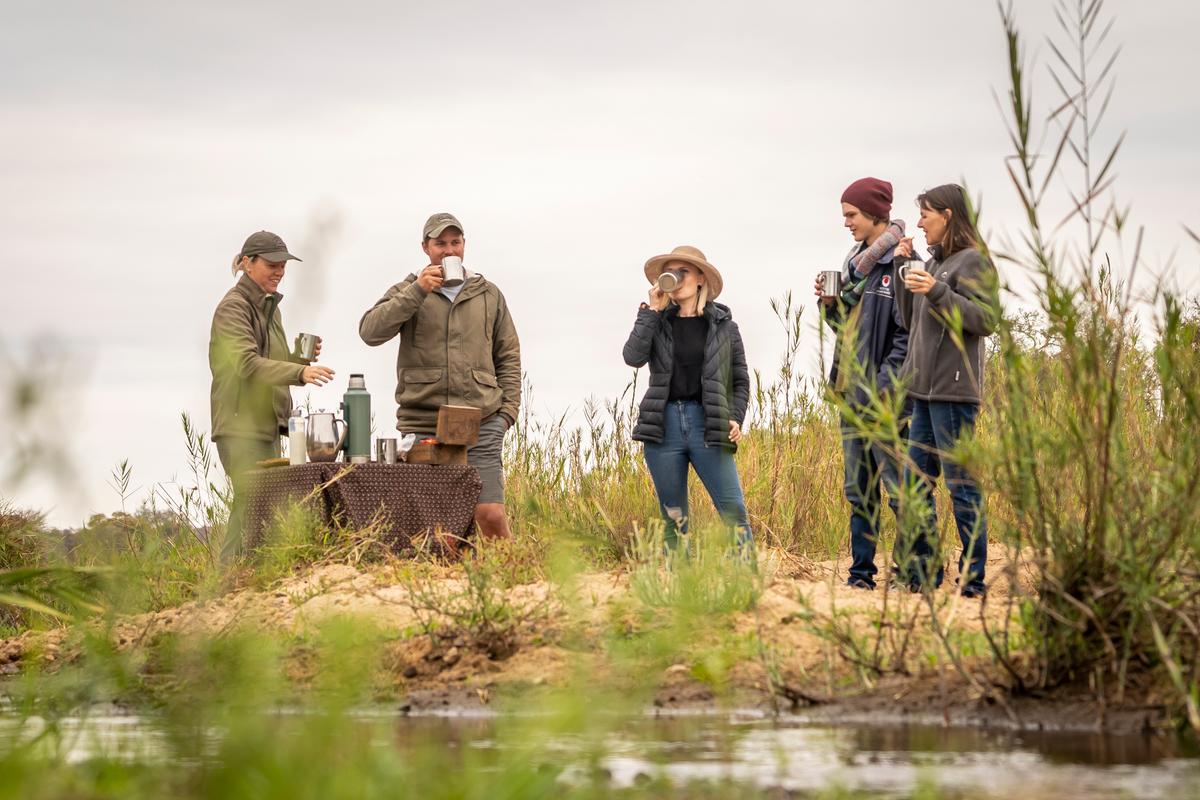In moments like these, the air feels more rare, time seems to slow down, and everything crackles with tension. Just a few minutes earlier, a call came over the radio and my guide, Khutso, quickly put our open-backed Jeep in gear. Doing his best imitation of a Formula One driver, he roared over the rough roads, me hanging on as we careened around corners. What’s waiting for us, I asked? “A surprise,” he said, looking over his shoulder for an instant—just long enough for me to see his wry smile.

Arriving, another jeep was already in place, and the guide motioned us to a spot nearby. And then we saw him: a big male leopard. Completely impervious to our presence, he was preoccupied with tracking something. Perhaps some small game, or, more likely, Khutso said, a female. He sniffed and stalked, back and forth, through the grass. Eyes laser-focused on his goal. We sat there, watching his every move, just barely breathing.

Of the famous Big Five, leopards are usually the most elusive. “Did you see all five?” people will ask, and many times I’ve responded, “Yes—everything but leopard.” And leopards like to hang out in trees, so even when you do spot one, it’s usually just a tail emerging from foliage.

So this was truly special. And just when we thought the show was over, the situation grew even more interesting. The big cat had disappeared for a moment, and we readied ourselves to leave. But then, a flash, next to the Jeep—and half a heartbeat later, a second flash. The first flash was a small antelope, a steenbok, running for its life. The second flash was the leopard hot on its tail, looking for dinner.
I was inside Klaserie Private Nature Reserve, one of many separate preserves attached to the world-famous Kruger National Park. Unlike many of the game reserves in other parts of Africa, Klaserie and its neighbors like Sabi Sand and Thornybush have dropped their fences and connected their land with Kruger. The result: a collective refuge for animals that is truly awesome in size.

Kruger itself covers about 8,000 square miles—roughly the size of the state of New Jersey. Add to that the so-called “Greater Kruger,” and you’ve got a constellation of attached, private parks covering an additional 1,350 square miles of protected flora and fauna.
Set in the extreme northeast corner of South Africa, the park shares borders with two countries—Zimbabwe and Mozambique. The land was set aside in 1898, and the park was formally established in 1926. Still considered far-flung, only three tourist cars visited Kruger the following year, in 1927.

Now, hundreds of tourist lodges welcome visitors to experience the wonders of Kruger. They range from simple, remote tented camps to luxurious villas with private plunge pools. One truly unique lodge, Kruger Shalati, has posh rooms built into train cars that are permanently fixed on a historic rail bridge over the Sabie River.
Even Klaserie itself is a wonder. Driving a short distance from Eastgate in Hoedspruit, the main airport used by safari-bound visitors, we entered the main gates of the reserve and were immediately surrounded by its splendor. About 232 square miles (around 10 times the size of Manhattan), the reserve was formed in 1960 when 36 farm owners decided to pool their resources, drop their fences, and preserve a wilderness. Here, you’ll find all of the Big Five animals, plus special creatures like cheetah and wild dogs, giraffes and zebras, and so much more.
Even the drive to the lodge provided glimpses of the wildlife to come—little warthogs trotting across the road, small clusters of springboks, and big, regal kudu with their grand, spiraling horns. My home for the next couple nights, a lodge called Klaserie Drift, has just six thatched suites and an infinity pool overlooking a big bend in the namesake river. Beyond, grasslands stretch to the horizon. Life quickly settled into a safari routine: early morning game drives; lazy afternoons in the pool, looking down on elephants down in the riverbed; afternoon drives with gin and tonic sundown drinks. And then, do it all again.
On our first drive, we saw the leopard. On our last, we had a few drinks with the hippos. The light quickly fading, Khutso curled our jeep toward a pond. We paused to observe a lone buffalo, a so-called “dagga boy,” a Big Five animal, older and solitary, his head and horns protruding from the water.
Then we proceeded to the other side for gin and tonics, paired with snacks like dried mango and biltong—dried and cured meat, a bit like an African beef jerky. The last streaks of sun laid down on the water, and the whole world seemed to slow down. Guinea fowl tiptoed past us, then flew up into a tree, their “apartment building,” Khutso said, where they’ll rest for the night. And out in the middle of the pond, two hippos snorted at us as if to say a grumpy “good night.” Just another lovely evening in the famous South African bush, surrounded by the endless wilderness of Klaserie and Kruger.

If You Go
Fly: Two U.S. carriers fly nonstop to Johannesburg’s OR Tambo International Airport: Delta from Atlanta, and United from Newark.






